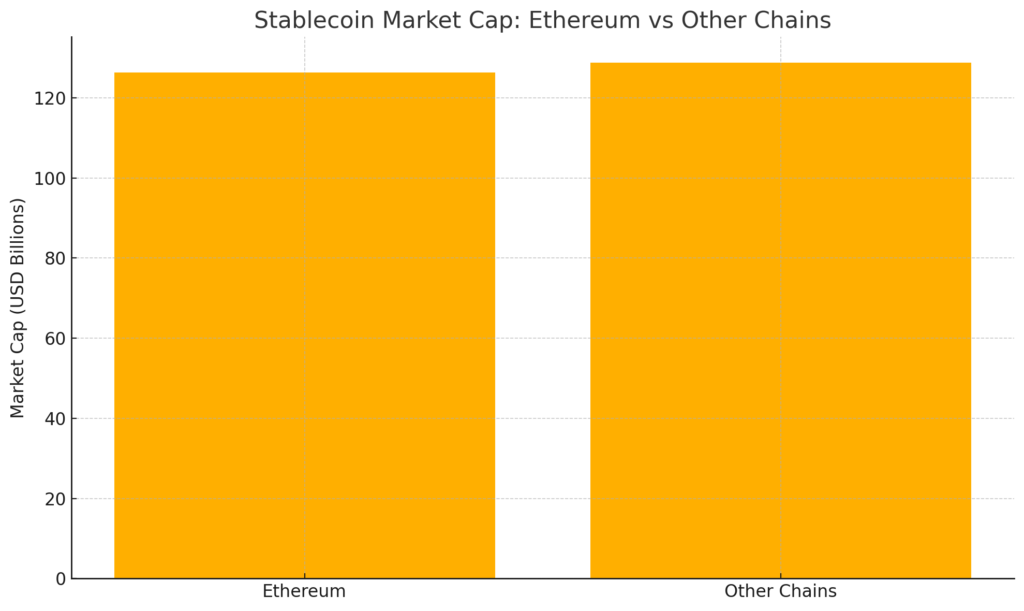
Main Points:
- Projected $10 billion ETF Inflows in H2 2025: Spot ETH ETFs attracted $1.17 billion in June alone and could see up to $10 billion by year-end, driven by institutional interest in stablecoins and tokenized equities.
- Tokenization Expands on Layer-2s: Robinhood’s “Robinhood Chain” on Arbitrum will host SpaceX and OpenAI equity tokens, underscoring Ethereum’s growing real-world asset platform role.
- Stablecoin Dominance on Ethereum: With $126.36 billion of stablecoins on-chain, Ethereum accounts for nearly 50% of the $255 billion total, adding $3.36 billion in the past 30 days.
- Staking Milestone Strengthens Fundamentals: Over 35 million ETH (~30% of supply) is now staked, reflecting rising confidence and a tightening supply.
- Pectra Upgrade and Beyond: The May 7 Pectra upgrade—introducing account abstraction, doubled blob capacity, and flexible staking—sets the stage for the upcoming Glamsterdam release and further scalability gains.
Institutional Inflows Set To Surge
The institutional narrative around Ethereum has never been clearer. In early July 2025, Bitwise CIO Matt Hougan forecast that spot Ethereum ETFs could attract as much as $10 billion in capital during the second half of the year. This builds on robust early momentum: ETFs funneled $1.17 billion into ETH in June alone, despite a brief pull-back of $403 million in March. With traditional investors drawn to the familiar concept of stocks and stablecoins migrating onto Ethereum, the straightforward narrative “stablecoins & stocks on Ethereum” is proving irresistible.
Moreover, the U.S. SEC’s approval of spot Ether ETFs in July 2024 demonstrated the maturation of regulatory frameworks, fueling confidence. As these funds gain traction, many analysts point to the potential for inflows to mirror or even exceed early Bitcoin ETF performance.
Tokenization’s Real-World Use Case
Ethereum’s role is shifting from a pure smart-contract platform to a hub for tokenized real-world assets. In late June, Robinhood announced it is building “Robinhood Chain” on Arbitrum to support tokenized stocks—including SpaceX and OpenAI—for global trading. This move highlights Ethereum’s Layer-2 networks as ideal hosts for asset tokenization:
- Familiar Asset Classes: Tokenized equities resonate with institutional and retail investors alike, simplifying blockchain adoption.
- Regulatory Compliance: Layer-2 environments can implement robust Know-Your-Customer (KYC) and Anti-Money-Laundering (AML) protocols.
- Interoperability: Assets tokenized on Ethereum can interact with DeFi, lending, and derivatives markets seamlessly.
As major platforms like BlackRock and WisdomTree file for new crypto ETFs (including Solana and XRP), Ethereum’s first-mover advantage in tokenization cements its position in decentralized finance’s next chapter.
Stablecoin Supremacy
Ethereum continues to dominate the stablecoin ecosystem. According to DeFiLlama, total stablecoin market capitalization surpassed $255 billion, with $126.36 billion—nearly 50%—issued on Ethereum alone. Over the past 30 days, Ethereum stablecoins grew by $3.36 billion, underpinning renewed DeFi activity.
The following chart illustrates Ethereum’s share versus other blockchains:

Stablecoin Market Cap: Ethereum vs Other Chains
Ethereum’s stablecoin dominance is fueled by leading issuers Tether (USDT) and USD Coin (USDC), which together represent over 86% of supply. This stable capital acts as on-chain liquidity for trading, lending, and institutional settlement, further solidifying Ethereum’s role as a programmable financial layer.
Pectra Upgrade: Laying the Foundation
On May 7, 2025, the Pectra protocol upgrade went live, marking Ethereum’s most significant post-Merge enhancement:
- Account Abstraction: Simplifies user onboarding by allowing smart contracts to manage key operations (gas payment, security policies).
- Doubled Blob Capacity: Increases data throughput for rollups, boosting Layer-2 transaction speeds.
- Flexible Staking Caps: Raises per-validator stake limits from 32 ETH to 2,048 ETH, facilitating institutional participation.
Despite concerns that Pectra alone might not immediately propel ETH prices—given a year-to-date decline of 45.5%—the upgrade reinforced Ethereum’s technical roadmap. With the next milestone, Glamsterdam, slated for late 2025, developers are optimistic about further gas fee reductions and enhanced modularity.
Staking Solidifies Long-Term Value
Ethereum’s shift to proof-of-stake has fundamentally altered its supply dynamics. As of late June, 35 million ETH—around 30% of total supply—is locked in staking contracts, reaching an all-time high. This reduced liquid float has several implications:
- Supply Crunch: Fewer ETH available on exchanges may support price stability.
- Yield Opportunities: Institutional and retail investors earn staking rewards (currently ~3.7% APR).
- Network Security: A larger staked base strengthens validation integrity.
However, staking centralization poses risks: Lido, Binance, and Coinbase together control nearly 40% of staked ETH, prompting calls for diversified validator participation.
Beyond DeFi: Enterprise and Innovation
While DeFi protocols hold over $61 billion in TVL, Ethereum’s ecosystem is branching into enterprise adoption:
- Consensys Partnerships: Collaborations with banks for tokenized trade finance.
- Blockchain-as-a-Service (BaaS): Platforms offering turnkey smart-contract deployment.
- Cross-Chain Integrations: Bridges enabling ETH use on networks like Polygon, Avalanche, and Cosmos.
Innovations such as EigenLayer’s restaking services promise higher risk-adjusted yields by allowing staked ETH to secure additional protocols, showcasing Ethereum’s expanding utility.
Conclusion
Ethereum stands at a pivotal inflection point. With $10 billion in ETF inflows on the horizon, tokenization initiatives on Layer-2 networks, a commanding stablecoin market position, and record staking participation, the network is poised for its next growth phase. Technical upgrades like Pectra—and the forthcoming Glamsterdam release—lay a robust foundation for scalability, user experience, and enterprise integration. For investors seeking new crypto assets, revenue streams, and practical blockchain applications, Ethereum’s evolving narrative offers a compelling blend of innovation and institutional legitimacy

